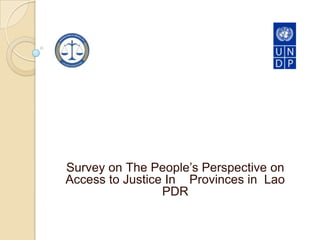A2 j survey workshop for launching 29 feb 2012
- 1. Survey on The People’s Perspective on Access to Justice In Provinces in Lao PDR
- 2. Specific Survey Objectives: ï‚— ï‚— To inform the development of concrete actions for the Legal Sector Master Plan; ï‚— ï‚— To build upon ongoing initiatives and successes to enhance access to justice across the country; ï‚— ï‚— To assist in the prioritization of issues, locations and target groups for legal awareness activities and legal aid assistance; ï‚— ï‚— To identify the best methods for conducting legal awareness activities; ï‚— ï‚— To identify additional strategies, entry points and to propose
- 3. Public Access to, or Interaction with, Justice Systems ï‚— ; ï‚— Lack of legal awareness is the main obstacle to people accessing the system; particularly formal mechanisms; ï‚— ; ï‚— A significant proportion of people have participated in legal awareness-raising activities and uniformly found it useful; ï‚— ï‚— People like participatory legal awareness activities or user-friendly media. However, they seem to prefer the source of the information to be official, albeit tailored to the local context ï‚— ï‚— Legal aid or assistance provision still seems to be relatively uncommon; particularly outside of Vientiane ï‚—
- 4. Public Confidence or Perception   People rely on local officials for accurate information about their rights and remedies.  - -  Customary mechanisms are most trusted, and most used, by the public - especially women - to resolve disputes.   Semi-formal or formal remedies, however, are preferred to resolve ‘external’ or ‘arm’s length’ disputes.   The process and treatment of participants is almost as important as the outcome in instilling confidence in any - informal, semi-formal or formal - justice system.   Public perception of the value-added by lawyers is low, but higher for free services,
- 5. Legal Awareness Priority Issues, Locations, and Target Groups   Demand for training on ‘all relevant laws’: especially, ‘justice-related issues’, family law, and ‘rights’.  -  Theft, drunkenness, unfair or unequal treatment, inequitable distribution of development assistance, drug abuse, domestic or other gender-based violence, adultery, trafficking, fights, and land disputes – arise frequently, so should also be a focus.   Targeted (regionally) training: e.g., human trafficking.   Enhanced awareness-raising in remote areas, far from courts.
- 6. A2J and the LSMP / LSMP Goal: To develop a coherent, credible and predictable legal framework established in a transparent and participatory manner, while at the same time building efficient, effective, equitable and accessible justice and law enforcement institutions and systems. / Links to LSMP: ï‚— = I, ï‚— A2J Rights Framework = Pillar I, Legislative Development ï‚— = IV, ï‚— Knowledge/Awareness = Pillar IV, Dissemination ï‚— = II, ï‚— Access/Interaction = Pillar II, Institutions ï‚— = III, II)
- 7. Additional Strategies, Entry Points, and Recommendations ï‚— ï‚— Setting up of public information centres in the courts, to make them more approachable and user-friendly; particularly to the poor and vulnerable. ï‚— ï‚— Investigation of possible establishment of mobile or circuit courts at the district level. ï‚— ï‚— Improvement of physical access to the courts, especially for the disabled. ï‚— ï‚— A clarified and more balanced relationship between the prosecution and judges, as well as with lawyers. ï‚— ï‚— A more regularised and transparent relationship between informal, semi-formal, and formal justice systems. ï‚— ï‚— Training of paralegals at the village or, at least, district levels. ï‚— ï‚— Harmonisation/integration of the system of petitions with administrative and judicial







